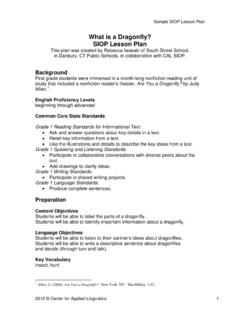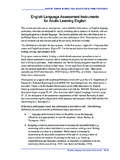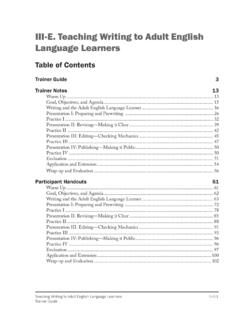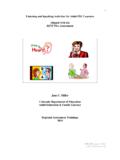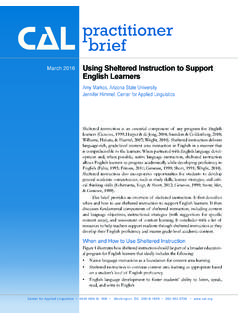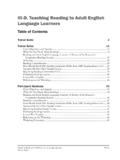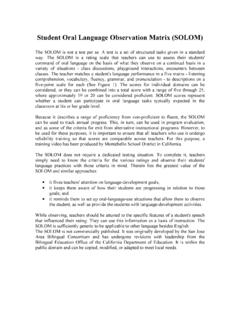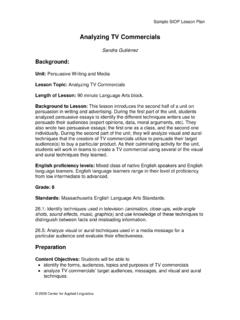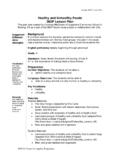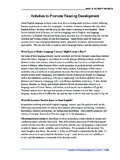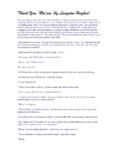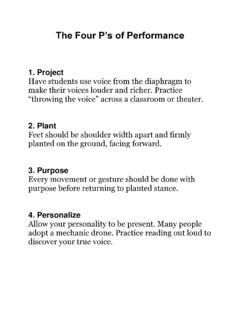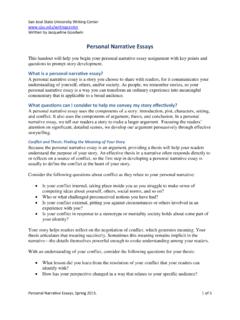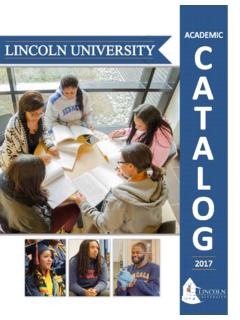Transcription of Sample SIOP Lesson Plan - Center for Applied Linguistics
1 Sample siop Lesson plan 2003 by the Center for Applied Linguistics This Lesson plan was created under the auspices of the Center for Research on Education, Diversity & Excellence. Educators may print copies without permission for their personal use or to share with colleagues. For other uses, permission must be requested in writing from the Center for Applied Linguistics . For more information on CAL's siop work, visit Figurative Language Lesson Barbara H. B. Formoso Prior Lesson : Class "Mosaic Poem" answering the question "What is poetry?" Standards: Virginia ELA "Students will and " Virginia ELA "Students will read a variety of poetry.
2 Students will describe the impact of specific word choices such or figurative language." ESL Standards: Goal 1, Standard 2; Goal 2, Standard 2; Goal 2, Standard 3 Objectives Content: Students will identify and formulate literal and figurative descriptions of familiar objects. Language Speaking and Listening: Students will work in small groups to formulate figurative descriptions of familiar objects. Reading: Students will read and interpret a poem. Writing: Students will write sentences using figurative language to describe familiar objects. Learning Strategies: focusing attention; visualizing Materials Copies and transparency of Langston Hughes' poem "Passing Love" Copies and transparency of T-chart : "Literal and Figurative" Blank transparency cut into 4 strips and a marker for each group 20 common household and classroom objects (staple puller, shell, drinking straw, etc.)
3 Sample siop Lesson plan 2003 by the Center for Applied Linguistics This Lesson plan was created under the auspices of the Center for Research on Education, Diversity & Excellence. Educators may print copies without permission for their personal use or to share with colleagues. For other uses, permission must be requested in writing from the Center for Applied Linguistics . For more information on CAL's siop work, visit Key vocabulary: literal, figurative, imagine, imagination Motivation Students read the Langston Hughes Poem, "Passing Love," and tell a partner what they think it means. Lead a brief class discussion of the poem focusing on the question, "How can a person be a song, a prayer, a rose?
4 " Steer the conversation to the imagination of the poet. Presentation Tell students that we are going to learn about how writers use their imagination to get powerful ideas across to the reader. With great mystery and suspense, pull an object from a paper bag (a staple puller), hold it up and ask students to identify it. Write the name in the literal column of the graphic organizer. Repeat for two or three more items (a shell, a crazy straw). Have students write the literal descriptions on their copy of the chart. Ask students to use their imagination to describe the objects in a sentence. Write them in the figurative column of the chart.
5 For example: "The fanged monster bit my finger!" "The frightened turtle would not come out." "The snake hid in the tall grass, waiting." Students copy the sentences on their chart. Practice Ask groups of three to choose a manager, a writer and a presenter. Give each group four transparency strips, a marker and a "mystery bag" with four more common objects. Tell students that they must "secretly" look at each object, and quietly decide together on the literal name and a figurative description for each (the other groups should not see or hear). The writer then writes the figurative language sentence on a transparency strip.
6 After the items have been returned to the bags, place them all mixed up in full view of the entire class. As each presenter comes to the overhead, s/he will ask the class to guess from the figurative sentence which object it describes. Students should record the literal and figurative descriptions on their chart for the first round. As time permits, each group can present a second object, and so on. Review Return to the Langston Hughes poem and ask students to identify the literal meaning of the poem, and the figurative language used by the poet. Sample siop Lesson plan 2003 by the Center for Applied Linguistics This Lesson plan was created under the auspices of the Center for Research on Education, Diversity & Excellence.
7 Educators may print copies without permission for their personal use or to share with colleagues. For other uses, permission must be requested in writing from the Center for Applied Linguistics . For more information on CAL's siop work, visit Wrap-up Ask students to think of one "Outcome Sentence" for today's Lesson to share orally: "After today's Lesson , I I was I Homework Students will complete the "Literal/Figurative" chart with five more literal and figurative descriptions of objects found at home. Follow-up Lesson Students will define the terms "simile" and "metaphor", identify them in a poem and use one of their figurative images to write a poem containing a simile or metaphor.
8
